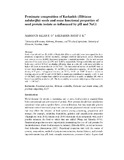Proximate composition of Karkadeh (Hibiscus sabdariffa) seeds and some functional properties of seed protein isolate as influenced by pH and NaCl

View/
Date
2009-05Author
Mahgoub Salah, E.O.
Elbashir Hayat Z.E.
Publisher
Informa Healthcare http://www.informaworld.comType
Published ArticleMetadata
Show full item recordAbstract
Seeds of an inbred line (B-11-90) of Karkadeh (Hibiscus sabdariffa) were investigated for their
proximate composition (AOAC methods), nitrogen solubility and protein isolate (Karkadeh
seed protein isolates [KSPI]) functional properties (standard methods). The fat and protein
contents of the seeds were 22.43% and 32.46%, respectively. Nitrogen solubility was good in
both water and 1.0 M NaCl at alkaline pH rather than at acidic pH, with better solubility at
higher pH levels in water than in 1.0 M NaCl. The functional properties of the KSPI were as
follows: water absorption capacity, 181 ml/100 g; fat absorption capacity, 110 ml/100 g; bulk
density, 0.77 g/ml; and apparent viscosity (at 208C), 13.42 cps. KSPI showed a maximum
foaming capacity at pH 12 and 1.6 M NaCl, a maximum emulsification capacity at pH 11 and
1.8 M NaCl, and a weaker foam stability at neutral pH than at acidic or alkaline pH, with a
better foam stability at alkaline pH. The foam stability was considerably improved by treatment
with 1.6 M NaCl.
